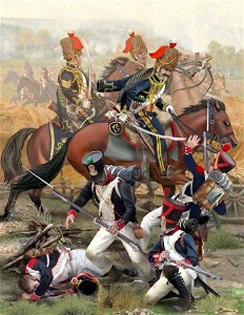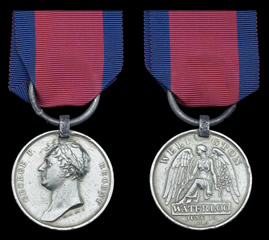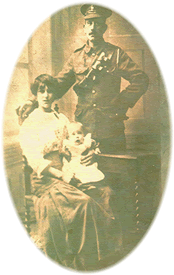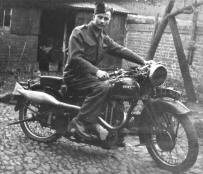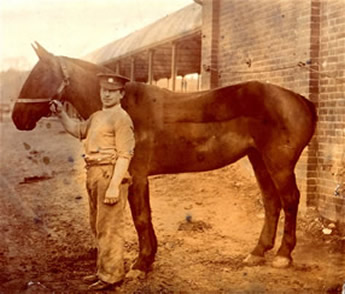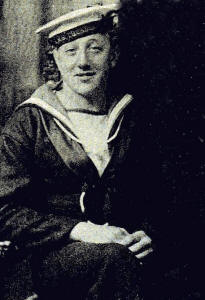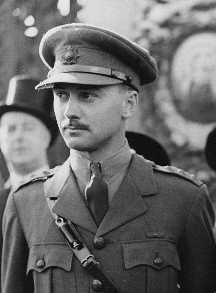
This page is dedicated to all in our extended family who served their country, and particularly those who gave their
lives in that service.
![]()
Fallen in the Great War
George Attenbrow, Private, 4th Bn. London
Regiment Labour Corps. Died 27 June 1918, age 21. Buried St
Julian's Churchyard, Kingston-By-Sea
Arthur Frederick Bellringer, Serjeant, 2nd Bn.
Rifle Brigade. Died 18 May 1915, age 24. Buried in Netley Military
Cemetery.
Edward Benson, Gunner, 21st Bty 22nd Bde., Royal Field Artillery. Died 15 November 1914, age 41. Commemorated on the Menin Gate.
Oswald Bere, Private, 'B 'Coy 2nd/8th Bn. Worcestershire Regiment. Died 28 August 1917, age 23. Remembered at Tyne Cot.
Stanley Bere, Private, 26th Bn. Royal Fusiliers. Died 11 June 1916, age 26. Remembered at the Etaples Military Cemetery.
Francis Blackler, Rifleman, 4th Bn. 3rd New Zealand Rifle Brigade. Died 16 June 1917, age 24. Buried at Trois Arbres Cemetery.
Arthur Blackmore, Leading Stoker, RN,
HMS Queen Mary. Died 31 May 1916 at Jutland , age 38. Remembered on the
Portsmouth Naval Memorial.
Ralph Henry Blake, Lance Corporal, 2nd/1st (South Midland) Field Coy, Royal Engineers. Died 16 Aug 1916, age 27. Buried in Puchevillers British Cemetery, The Somme.
Albert Bubear, Private, 12th Bn. Middlesex Regiment. Died 15 July 1916, age 24. Remembered on the Thiepval Memorial.
Albert G. Bubear, Private, 13th (Princess Louise's Kensington) (County of London) Battalion, The London Regiment, attd. 170th Tunneling Coy. Royal Engineers. Died 27 July 1917, age 28. Buried in Bethune Town Cemetery.
George Bubear, Private, 1st/7th (City of London) Bn. London Regiment. Died 7 October 1916, age 23. Remembered on the Thiepval Memorial.
Walter G. Bubear, Private, 1st Bn. Queen's Own (Royal West Kent Regiment). Died 29 August 1918, age 24. Remembered on the Vis-en-Artois Memorial.
William J. Bubear, Private, 15th Bn. Hampshire Regiment. Died 20 September 1918, age 29. Commemorated at Tyne Cot.
Ernest W. Burridge, Private, 6th Bn. Welsh Regiment. Died 27 October 1917, age 29. Buried in Dozinghem Military Cemetery.
Fred Burridge, Serjeant (Master Tailor), 1st Garrison Bn. Devonshire Regiment. Died 2 June 1916, age 43. Buried in the Cairo War Memorial Cemetery.
Frederick Cann, Private, 2nd Bn. Devonshire Regiment. Died 1 July 1916, age 23. Remembered on the Thiepval Monument.
Robert Colbourne, Midshipman, RN, HMS Vanguard. Died at Scapa Flow 9 July 1917, age 20. Commemorated at Chatham Naval Memorial.
Edward J. Conibeer, Driver, Army Service Corps
Mechanical Transport, attd. 1st Reinforcement Training Camp. Died
2 November 1918, age 33. Buried in Terlincthun British Cemetery,
Wimille.
Ernest S. Cook, Rifleman, 8th Bn. King's Royal Rifle Corps. Died 30 July 1915, age 23. Buried at Sanctuary Wood.
William A. Copeman, Private, 7th Bn. East Surrey Regiment. Died 5 March, 1916, age 19. Remembered at the Loos Memorial.
Arthur W.P.Daw, Artificer Engineer, RN, HMS Bulwark. Died 26 November 1914, age 37. Remembered on the Portsmouth Naval Memorial.
Reginald Daw, Private, 49th Bn. Australian Infantry. Died 7 June 1917, age 23. Commemorated at the Menin Gate.
Victor S. Dixon, Lance Corporal, 41st Bn. Australian Infantry. Died 27 June 1917, age 27. Commemorated at Kandahar Farm.
Frederick Drew, Private, 2nd Bn. Devonshire Regiment. Died 1 July 1916, age 28. Remembered on the Thiepval Memorial.
John Drew, Private, 8th Bn. Canadian Infantry (Manitoba Regiment). Died 28 April 1917, age 24. Buried at Orchard Dump Cemetery.
William Drew, Private, 1st/6th Bn. Devonshire Regiment. Died in Iraq 8 March 1916, age 19. Commemorated at the Basra Memorial.
Charles Fey, Private, Depot, Gloucestershire Regiment. Died 17 October 1918, age 21. Buried at Arnos Vale Cemetery, Bristol.
Frederick Fey, Private, 2nd/4th Bn. Gloucestershire Regiment. Died 27 August 1917, age 21. Buried at New Irish Farm Cemetery.
Luke Fey, Lance Corporal, Machine Gun Corps. Died
9 November 1916, aged 40. Buried in Heilly Station Cemetery,
Mericourt-L´Abbe .
James Frost, MM, Corporal, 10th Bn. King's Royal Rifle Corps. Died 9 May 1917, age 21. Commemorated on the Thiepval Memorial.
Arthur Fursdon Gallin, Private, "B" Coy, 8th Bn., Devonshire Regiment. Died 25 September 1915, age 24. Remembered on the Loos Memorial.
Lewis Wilberforce Goldsmith, Captain, 7th Bn.,
Yorkshire Regiment. Died 5 November 1916, age 21. Remembered on
the Thiepval Memorial.
Arthur Grubb, Private, Machine Gun Corps (Infantry), 14th Bn. Died 21 March 1918, age 27. Remembered at the Pozieres Memorial.
George Hammond, Private, 2nd Bn Royal
Warwickshire Regiment. Died 4 May 1917, age 24. Commemorated on
the Arras Memorial.
Harold Heard, Private, 12th Bn. Royal Scots. Died on the Somme, 16 April 1918, age 19. Commemorated at Tyne Cot.
Henry Heard, Gunner, "A" Bty 154th Bde. Royal Field Artillery. Died 4 July 1916, age 36. Buried in Acheux British Cemetery.
Horace Heard , Private, 7th Bn. Seaforth Highlanders. Died 6 October 1915, age 21. Buried in Boulogne Eastern Cemetery.
Paul Lenton Heath, Guardsman, 1st Bn.
Grenadier Guards. Killed in action, 30 March 1918, age 31. Buried
in Bucquoy Road Cemetery, Ficheux.
William Hitchcock, Private, 8th Bn. Devonshire Regiment. Died 25 September 1915, age 20. Commemorated on the Loos Memorial.
Cecil Huxtable, Lance Corporal, 28th Bn. Australian Infantry. Died 4 October 1917, age 28. Remembered at Tyne Cot.
William Leach, Private, 17th Bn. Royal Fusiliers. Died 4 December 1917, age 20. Buried in Grevillers British Cemetery.
William Lee, Petty Officer Stoker,RN, HMS Hampshire. Died 5 June 1916 age 33. Remembered on the Portsmouth Naval Memorial.
Albert Loye, Private, 4th Bn. Royal Fusiliers. Died at Ypres, 24 August 1915, age 42. Commemorated at the Menin Gate.
Frederick Loye, Gunner, 351st Siege Bty. Royal Garrison Artillery. Died on the Somme, 6 November 1917, age 40. Buried at Tyne Cot.
Reginald P. Loye, Private, 12th Bn. Royal Fusiliers. Died 31 January 1917, age 40. Buried in Lillers Communal Cemetery.
Arthur Meecham, Private, 11th Bn. Worcestershire Regiment. Died 24 April 1917, age 20. Remembered at the Doiran Memorial.
Leonard V. Miles, Private,
4th Bn. Duke of Cambridge's Own (Middlesex) Regiment. Died 16 Nov 1916, age 19. Remembered on the Thiepval Monument.
Archie Mortimore, Private , 1st/6th Bn. Devonshire Regiment. Died 14 August 1916 in Mesopotamia, age 23. Buried in Amara War Cemetery.
Frederick Narracott, Private, 2nd Bn.
Devonshire Regiment. Died 31 October 1916, age 32. Buried at Grove
Town Cemetery, Méaulte.
Reginald Newcombe, Gunner, "X" 9th T.M. Bty, Royal Field Artillery. Died 22 March 1918, age 21. Remembered at Pozieres.
George Northcott, Private, 1st Bn. Dorsetshire Regiment. Died 19 April 1918, age 35. Buried in the Bienvillers Military Cemetery.
Charles Osborne, Able Seaman,RN, HMS Defence, Royal Navy. Died 31 May 1916, age 21. Remembered at the Plymouth Naval Memorial.
William Osborne, Private, 2nd Bn. Hampshire Regiment. Died 13 August 1914, age 41. Remembered on the Helles Memorial.
John Parkyn, Serjeant, 2nd Bn. Devonshire
Regiment. Died 28 June 1918, age 25. Buried in the Church of the
Holy Cross, Crediton.
Percy J. Partridge, Private, 12th Bn. Gloucestershire Regiment. Died 25 August 1918. Buried in Adanac War Cemetery, Miraumont.
Daniel Passmore, Private, 2nd Bn. Devonshire Regiment. Died 18 December 1914, age 21. Commemorated on Le Touret Memorial.
Ernest Pickard, Private, 10th Bn.
Royal Fusiliers. Died 14 September 1918, age 27. Commemorated at
Vis-en-Artois Memorial.
John Pickett, Private, 3rd Bn. Royal Fusiliers. Died 24 May 1915, age 35. Commemorated at the Menin Gate.
John (aka Leslie Loye) Pitts, Driver, 65th Bty, Royal Field Artillery. Died 20 Sep 1914, age 16. Buried at St. Nazaire (Toutes-Aides) Cemetery.
Frederick Pyman, Sergeant, 12th Bn. Gloucestershire Regiment. Died 23 March 1916, age 36. Buried at Habarcq Cemetery.
George Rolls, Private, 7th Bn. London Regiment. Died 17 May 1915, age 30. Buried in the Merville Communal Cemetery.
George Saffin, Private, 1st Bn. Devonshire Regiment. Died 27 March 1915, age 29. Buried at Kemmel Chateau Military Cemetery.
James Sharland, Lance Corporal, 8th Bn. Devonshire Regiment. Died 25 September 1915, age 36. Remembered on the Loos Memorial.
Bertie Strong, Private, 50th Bn. Alberta Regiment, Canadian Infantry. Died 20 November 1916, age 31. Remembered on the Vimy Memorial.
Frederick Strong, Stoker First Class, RN, HMS Good Hope. Killed in the Battle of Coronel 1st November 1914, age 25. Remembered on the Plymouth Naval Memorial.
Albert Tucker, Private ,1st Bn. Devonshire Regiment. Died 12 December 1915, age 27. Buried at Cerisy-Gailly Military Cemetery.
Hubert J. Venn, Private,
Princess Patricia's Canadian Light Infantry (E. Ontario Reg.) Died 10 April 1918, age 43. Buried at La Chaudiere Military Cemetery
Thomas Albert Walden, Battery Quartermaster
Serjeant , 64th Siege Battery, Royal Garrison Artillery. Died 28
August 1917, age 32. Buried in Coxyde Military Cemetery, Koksijde.
Merlyn Waller, Private, 9th Bn. Devonshire Regiment, Died between
4 and 6 September 1916, age 20. Commemorated on the Thiepval Memorial.
William Wensley, Private, 3rd Bn. Grenadier Guards. Died 29 September 1917, age 20. Commemorated at Bleuet Farm.
Alfred Willing, Private, 9th Bn. Devonshire Regiment. Died 30 September 1915, age 29. Commemorated on the Loos Memorial.
Robert Willing, Private, 9th Bn. Devonshire Regiment. Died 1 July 1916, age 23 . Buried in the Devonshire Cemetery, Mametz.
Thomas Woods, Lieutenant, 4th Bn. Suffolk
Regiment, attd. 11th Bn. Died 22 March 1918 age 21.
Commemorated at the Arras Memorial.
In the Baptismal Register for St Swithun's Parish Church, in Sandford, after the Great War, an incumbent or parish clerk has revisited the register for parishioners baptised there in the 1880s and 1890s. He has added to their register entries inscriptions such as "Killed in Flanders 1917", " Lost both arms in France in 1916" " Died in France, 1915". These poignant additions are to be found below far too many baptisms for a tiny village of some 1200 souls.
|
|
|
|
Laurence Binyon, For the Fallen |
|
Lucknow
John Fursdon, husband of Maria Drew, Private in the 20th East Devon Regiment of Foot was killed in action storming the mutineers at the Siege of Lucknow, India on 14th March 1858
The Siege of Lucknow was the prolonged defence of the Residency within the city of Lucknow during the Indian Mutiny. After two successive relief attempts had reached the city, the defenders and civilians were evacuated from the Residency, which was abandoned.
John seems to have been in one of the columns attempting the relief of the Residency.
British soldiers at Lucknow
Charles Carter
Father of great-aunt Charlotte, Charles Carter served for over 24 years in the 10th (Prince of Wales' Own) Royal Hussars, joining in 1846 aged 17 and retiring in 1870. He rose through the ranks from
 Private to Corporal, then Sergeant and Troop Sergeant Major and finally holding the rank of Squadron Quarter Master Sergeant, when he retired.
He served for eight years in the East Indies, then fought in the Crimea and was at the fall of Sebastopol. The regiment took him all over England, and he was stationed in London, Yorkshire, Norfolk and Aldershot. The regiment moved to Ireland for 5 years in 1863, dealing with the 'Fenian' troubles. It was there in Dundalk that his daughter Charlotte was born, wife of great uncle John Prettejohn Pitts.
Charles' wife Annie Brown was the daughter of a barracks sergeant George Brown, also a Chelsea Pensioner.
He was awarded a Medal for service in the Crimea with a clasp for the fall of Sebastopol, the Turkish Crimean medal and a medal for good conduct and long service.
He settled in Yorkshire, but had only 7 years to enjoy his retirement, dying there in 1877.
Private to Corporal, then Sergeant and Troop Sergeant Major and finally holding the rank of Squadron Quarter Master Sergeant, when he retired.
He served for eight years in the East Indies, then fought in the Crimea and was at the fall of Sebastopol. The regiment took him all over England, and he was stationed in London, Yorkshire, Norfolk and Aldershot. The regiment moved to Ireland for 5 years in 1863, dealing with the 'Fenian' troubles. It was there in Dundalk that his daughter Charlotte was born, wife of great uncle John Prettejohn Pitts.
Charles' wife Annie Brown was the daughter of a barracks sergeant George Brown, also a Chelsea Pensioner.
He was awarded a Medal for service in the Crimea with a clasp for the fall of Sebastopol, the Turkish Crimean medal and a medal for good conduct and long service.
He settled in Yorkshire, but had only 7 years to enjoy his retirement, dying there in 1877.10th Royal Hussar Officer 1845
The Willing Brothers
War memorials throughout the country bear testament to the losses suffered within families, the same names re-occurring. Robert and Alice Willing lost two of their four sons. Robert was a successful architect, living in Dartmouth at the start of the war. All their sons signed up. Both eldest son Alfred and youngest son Robert enlisted in the 9th battalion of the Devonshire Regiment.In September 1915, 29 year-old Alfred was killed in the Battle of Loos - a massive offensive by the Allies that saw the first use of gas by the British. Lack of wind meant the gas lingered across the Devonshire Regiment's front. Initially successful, the attack petered out, with no effective reserves in support. The fighting had subsided by 29th September. Alfred's medal card reads "Death regarded 30.9.15" - perhaps the date when his body or personal effects were found. He is commemorated on the Loos memorial.
In the following year Alfred's 23 year-old brother Robert was killed on the first day of the Battle of the Somme, at Mametz, in the action described below.
Arthur Joseph Grub
Arthur Grubb married in 1911, aged 21, and joined up in 1914, serving first in training camps in England. His daughter Annie was born in May 1915. She was 6 months old before he saw her. He was soon posted to France. Arthur served in the Kings Royal Rifle Corps, then the Machine Gun Company. Whilst surrounded by death and destruction in the trenches he found time to embroider this handkerchief as a gift for his daughter. The Germans launched their last great offensive in Spring 1918. Arthur went missing on the first day,21st March 1918, the battle of Saint-Quentin. His daughter was to treasure the gift made for her by the father she never knew.


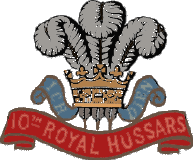
Privates Robert Willing (l)
and Alfred Willing (r)
.jpg)
Pte. Arthur Grub
Reginald Loye
Not all deaths in France were from enemy action. Second cousin Reginald Loye, like his father before him, qualified as a solicitor. After the death of his father he joined Lloyds Bank, and in 1914 was working at their Cheltenham Road, Bristol branch. With a history of military service in his mother's family that stretched back to the early years of the 17th century, unsurprisingly Reginald volunteered for foreign service on the outbreak of war in August 1914. He failed the medical. Undeterred he managed to join the Bankers’ or Stockbrokers' Battalion of the Royal Fusiliers in March 1916, aged 39. He arrived in France in August of that year and joined the 12th Battalion at Dernancourt on the Somme. Within days he was plunged into battle, the battalion suffering daily from artillery and gas attacks. Reginald was constantly employed on special duty and patrol work during the autumn and winter of 1916-17. The Battalion War Diary tells us that the weather was exceptionally bitter in January 1917, freezing, with considerable snow falls. Whilst undergoing a course of machine-gun instruction under canvas in those wretched conditions, Reginald contracted pneumonia. His death was recorded at the 2/1st West Riding Casualty Clearing Station on 31 Jan 1917. He is buried at Lillers.Fred Frost
Another cousin in our Loye family, Fred Frost, joined the Territorials just a day or two before his sixteenth birthday in 1912. When war broke out he transferred into the Royal Field Artillery and was sent to France on 15th March 1915. Gunner Frost was serving with his battery on about 22nd May 1916 when it came under heavy fire. Fred was severely burned in an explosion and was evacuated to a casualty clearing station. He had suffered burns to his face, arms, hands, back and legs. It was clear from the letters written to his mother by the Sister-in-Charge at the Clearing Station that his survival was in doubt. "He has been burnt in an explosion and I am afraid is very bad. You may be sure we shall do everything we can for him."
Fred was moved to the base hospital at Rouen. He made some progress, and the Sister there was able to write that his face had already healed. But on 18 June 1916 "it was found necessary to amputate his left arm. It was burnt too badly to save." Fred was moved back to the UK where he continued to receive care. He was discharged from the Army on 21st August 1917, as being "no longer fit for War Service". He married my cousin Doris Rouse in 1921, and they had 10 children. For many years Fred and Doris lived in an Earl Haig home. Fred died of TB in 1951.
Vic Annett
Albert Victor Annett (Vic) was born in Heywood, Victoria Australia in 1890. When war broke out he was a farmer. He enlisted in 1915, and almost a year later he embarked for England, a member of the 10th Field Ambulance.The Field Ambulance was a mobile front line medical unit (not a vehicle).The Ambulance was responsible for establishing and operating a number of points along the casualty evacuation chain, including relay posts and dressing stations. It also provided a Walking Wounded Collecting Station.
Vic disembarked at Plymouth in July 1916 and in November 1916 he was sent to France. He suffered synovitis (inflammation of joints) and had two spells in hospital in 1917. Then in October 1917 he received a gun shot wound. But he was soon back with his unit and back in action. In May 1918 he was wounded a second time by a gunshot. On this occasion his scapula was broken, and he was invalided back to England.
Before he had left Australia, his brother-in-law George Saffin had asked him to look up his family in Cheriton Bishop, Devon, if he had a chance. Whilst he was convalescing he took the opportunity to visit the Saffins. He fell in love at first sight one imagines, as during that period he actually married one of the Saffin daughters, Bertha, in Cheriton Bishop. He sailed back to Australia in January 1919, and she followed.
 |
 |
 |
| Reg Loye | Fred Frost at a
Military Hospital, front row 3rd from right |
Vic Annett |
Sergeant Fred Burridge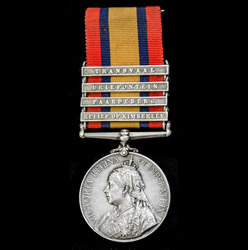 A Queen's South Africa medal with clasps for Transvaal, Driefontein, Paardeberg and Relief of Kimberley |
Fred Burridge had an extraordinary military career. The eldest son of Frank Burridge, shoemaker, and Elizabeth Inch, of variously Stanbury Court, Landscore and High Street, Crediton, he was working as a tailor when he enlisted in the Oxford Light Infantry in 1893, aged 20. He served in the UK , and by 1899 he was promoted to Corporal. In December 1899 he shipped out to South Africa, to play his part in the second Boer War. In February 1902 with eight Mounted Infantry he set off from Bloemfontein towards Buffou when they were cut off by a large party of Boers. He was stripped of everything he was wearing and left to do the best he could. It took him eight days to get back to his unit. He was promoted to sergeant for his good service in the field. When he returned to England in 1902 he had been awarded the Queen's South Africa medal with clasps for Transvaal, Driefontein, Paardeberg and Relief of Kimberley, and the King's South Africa medal with clasps South Africa 1901 and South Africa 1902. His home postings thereafter included the Curragh in County Kildare, where his son was born, and Chatham, Kent. In 1905 he qualified as a master tailor and having extended his service and transferred to the 1st Bn., Royal Berkshire Regiment in 1908, he was promoted to Sergeant Tailor in the following year. He was discharged on 14 September 1911, and returned to Crediton. Then in 1914, despite his 18 years of service, and his age of 41, on the outbreak of the World War he enlisted again. This time he joined the Royal West Kent Regiment, and was made an acting sergeant immediately. However this did not last long, for after 19 days he was medically discharged with oedema in the right ankle, and enteric legs. The MO wrote on his discharge papers, " This man is quite unable to march because of weakness in his legs". Despite this, somehow Fred managed to go on to enlist in the Devonshire Regiment. He joined the 1st Garrison Battalion. Formed in August 1915, this comprised men who, although unfit for battle, were capable of discharging garrison duties. He was appointed Sergeant (Master) Tailor. On 15 October 1915 Fred sailed with the battalion to Cairo. This was his last posting, for on 2 June 1916 Fred died. He was buried in the Cairo War Memorial Cemetery. In 1920 Fred was posthumously awarded the 1915 Star, the Victory Medal and the British War medal. His effects were left to his son. |
|
Private Harold Heard
Private Harold Heard,
Harold Heard's Memorial Plaque.
|
Private No 331075 Harold Edward Heard, of the 12th (Service) Bn The Royal Scots (Lothian Regt.) was the eldest son of Harry and Lucy Heard of 149 Princess Street, Burton-on-Trent. Harry had been born in Devon, and moved to Leamington Spa, Warwickshire, with his family, where he found work with the Midland Railway Company, first as a porter and then a carriage shunter. He married servant Lucy Nicks in 1897 and the following year their first child was born in Burton-on-Trent where the family had moved. Harold was born on 13 August 1898. He went to the local school, and then like his father, he found employment with the railways, working for the Railway Clearing House, Burton-on-Trent, as did his younger brother Edgar. He enlisted on 3 August 1915, 10 days short of his 17th birthday. He first joined the 6th Bn. North Staffordshire Regiment, which was a Territorial regiment, and later transferred to the 12th Bn Royal Scots. He served with the British Expeditionary Force in France and Flanders from 19 November 1915. He would have participated in the Battle of the Somme with the Royal Scots in 1916, when his battalion lost 104 killed and 403 wounded or missing. The 12th Bn was in action at Arras in April-May 1917 and at Passchendaele in September and October 1917. April 1918 saw a major German offensive in Flanders intended to break through the British First Army, push the Second Army aside to the north, and drive west to the English Channel, cutting off British forces in France from their supply line. This Lys Offensive around the town of Armentières, the offensive straddling the Franco-Belgian border, saw several battles between 7 and 29 April as the Germans advanced. The Royal Scots were engaged in The Battle of Messines, 10-11 April, The Battle of Bailleul, 13-15 April, The First Battle of Kemmel, 17-19 April and The Second Battle of Kemmel, 25-26 April. From 13–15 April, the Germans drove forward in the centre, taking Bailleul, 7.5 miles west of Armentières, despite increasing British resistance. Harold was killed in action on 16 April 1918 in the Armentières sector. It seems probable that his death was a result of this German push.
He was awarded the Victory Medal, the British War Medal and the 1914-1915 Star.
In World War II Harold's younger sister Lucy was to lose her husband Harold Parker on HMS Harvester in 1943, and younger sister Marjorie was to lose her husband Reginald Adkins in a Japanese POW camp in 1945. |
|
Lance Corporal James Sharland |
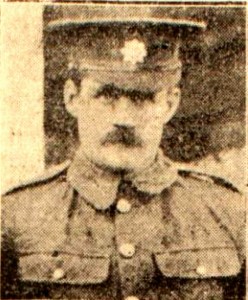 Lance Corporal James Sharland  Loos Memorial Loos Memorial |
In many ways James Sharland was typical of the village men from parishes throughout the United Kingdom who lost their lives in the First World War. James was born on 14th May 1878, in Pages cottage in the village of Cruwys Morchard in Mid-Devon, to James Sharland, a farm worker or sometimes a road worker. His mother Eliza née Crook was a post woman. He was the eighth child of seven boys and five girls. On 16 July 1883 he enrolled at Cruwys Morchard Village School. But by 1891 like many children in rural Britain he had left school and he was working as a farm servant. Farm servants tended to be on fixed term contracts of 6 to 12 months, and unlike agricultural labourers, who worked in the fields, servants tended to work around the farm house, in stables, barns or dairies, though they would have helped with the harvest. Then James seems to have joined the Navy for 12 years in 1896, as a stoker, though his service record suggests he spent as much time at shore bases as he did at sea. His father died in 1907, and James left the Navy in the following year, and like his father before him, he found work as a road labourer. He worked for Tiverton Rural District Council, and continued living with his widowed mother at Penny Moor, Cruwys Morchard. On 8 April 1912, in Cruwys Morchard Parish Church, he married Rosa French, daughter of a labourer. Both signed their names in the register. James too was recorded as a labourer. Their first child, Arthur, was born some three months later, on 4 July 1912. He was followed by Wilfred in 1913, and Lionel in 1914. Between the birth of Lionel, in June, and his baptism in September, World War I began. Though volunteering for the Colours was slower to get started in Devon than in the rest of England, James joined up soon after the outbreak of war. Despite the absence of his attestation papers it is likely that he joined the 8th Battalion of the Devonshire Regiment in the later months of 1914 or early in 1915. In a few months he was considered trained and fit for service, when he and the 8th Bn. Devonshires embarked for Le Havre, landing on 25-26th July 1915. They were posted to 7th Division, 20th Brigade. On 25th September 1915 the British launched the Battle of Loos. It was the biggest British attack of 1915, the first time that the British used poison gas and the first mass engagement of New Army units. The French and British tried to break through the German defences in Artois and Champagne. Despite improved tactics, more ammunition and better equipment, the Franco-British attacks were largely contained by the Germans. The British gas attack failed to neutralize the defenders, and the artillery bombardment was too short to destroy the barbed wire or machine gun nests. The Germans mounted a superior defence, resulting in a British defeat. After the first days of the battle, Lance Corporal James Sharland was missing. It was over a year, in October 1916 that James was announced as having been killed on or about 25th September 1915. One of the 1,114, 914 British Imperial Forces who were killed in the First War. He was commemorated on the Loos Memorial, on stone number 35B. He was posthumously awarded the Victory Medal, the British War Medal and the 1915 Star |
Stoker PO Walter Labbett |
|
 HMS Russell HMS Russell |
Walter Labbett was born in Paddington in 1888, the son of Metropolitan Policeman John, and my great-great aunt Maria Fey. He was working as a barman when he enlisted in the Royal Navy in 1909, shortly after he had married. He served as a Stoker, and in his early years was posted to a number of ships and shore bases including 2 years on the battleship HMS Lord Nelson, and several months on the cruiser HMS Falmouth. At the outbreak of World War I he was a Leading Stoker on the battleship HMS Russell. In the early part of the war she was with the Grand Fleet on Northern Patrol, and in November 1914 bombarded German occupied Zeebrugge. In November 1915 she was sent to the Mediterranean to support the Dardanelles Campaign. Tragedy struck on 27 April 1916 when she was sailing off Malta and struck two mines laid by a German U-boat, and sank. Most of her crew survived the sinking, though 125 men were killed. Walter was "reported to have been saved following the sinking of HMS Russell" on the Casualty List issued by the Admiralty on 4th May 1916. But after a period ashore Walter was soon back at sea serving on the cruiser HMS St George, where he was made Stoker Petty Officer. He served at Salonika and his war ended on the cruiser HMS Latona. Walter was to serve another 12 years in the Navy, spending several years on the Mediterranean station where he was part of the fleet supporting the Greeks in the Greco-Turkish war in 1922. He was discharged in 1931, but re-enlisted at the outbreak of World War II in 1939. He served then at Chatham Naval Base, but was admitted to the Naval Hospital in 1941, which brought an end to his service. Father of six, he survived to 1980, when he died in Edgware. |
Doing Their BitIn common with most families, our parents', grandparents' and great-grandparents' generations served their country when needed. Some were called up, many volunteered, or were serving in the reserves, militias or territorials. A few were regulars. Our earliest certain Heard ancestor, John Heard, was in the Royal Cornwall Militia, stationed at Crediton, when he met his wife Susannah Crossman in the 1790s. His daughter Susannah married John Southcott, a private in the Devonshire Regiment of Militia. Great (x3) grandfather John Berry was a private in No 1 Coy. on the nominal roll of the 1st Crediton Volunteers, January 1st, 1805. Three years earlier he and his father-in-law John Prawl had attended the muster in Exeter when the threat from Napoleon had seemed great. In 1887 the nominal roll of G Coy. (Crediton) of the 1st Rifle Volunteers, the Devonshire Regiment, included the names of several of our family. Devonshire being a seafaring county, we have had our share of sailors, including John Bate who joined in 1866, and served for 20 years, James Heard who enlisted in 1894 and Walter Bubear who joined the Royal Navy at 18 in 1896, and served until 1919. William Lee, descended from our Smallridges, was a Petty Officer Stoker who perished with Lord Kitchener in the mysterious sinking of HMS Hampshire in 1916. Moses Farthing served as a Stoker on HMS Renown and HMS Attentive between 1916 and 1919. Our women too did their bit, including several Wright sisters and cousins who were nurses during WWII, two of whom appear below, alongside men of the family photographed during their service. |
|||
|
Cecil Huxtable1889-1917 |
 George Roden 1886-1951 |
 Will Madge 1892-1983 |
 Thomas Chisholm 1921-1957 |
|
|
William Willing 1891-1950 |
 Ernest Pickett 1883-1959 |
|
 James Farthing 1891-1959 |
 Betty Wright 1920-2005 |
|
 Frederick Heard 1922-2007 |
 Peggy Wright 1921-1979 |
Albert Fey 1884-1958 |
 Jack Turner 1894-1935 |
 John Heard 1934-1996 |
 Fred Wright (1880-1946) in Ireland (seated right) |
|
Corporal John Crofton Sadleir enlisted in Australia on 17th Jan 1916, aged barely 16 but giving his age as 21. He was wounded twice in action in France (1917). He then re-enlisted in 1940, understating his age by three years and without mentioning his previous service. He was killed in action at Sidon, Lebanon, during the operation against the Vichy French. He was mentioned in dispatches (London Gazette 30th Dec 1941). | |
| William Park (1883-1970) had only been in Australia a few years when the First World War broke out. He enlisted in the 11th Battalion of the Australian Imperial Force in September 1914, one of the first infantry units raised at the beginning of the war. He took a couple years off his age when he enlisted. He served with the 11th Bn in Egypt, Gallipoli and France. Bill was wounded, and sent to convalesce in England, where he married. With the coming of WWII Bill enlisted again. Aged 57, he gave his age as 50 so that he could join up. He served from 1941 to 1949 as a member of the 10th Garrison. Bill had 6 sons, and all served. Two were prisoners of war - Happy escaped from the Germans and fought with Italian guerrillas for three years. Lance was a prisoner of the Japanese for five years. Stanley was a Desert Rat, and fought at Tobruk. Edgar served with the air force in the Pacific islands. One of his younger sons served in Korea, and another in Vietnam, and the tradition continued, with Bill's grandsons also serving in Vietnam. |
|
||
|
|
John Berry Wright with horse Kitty |
||
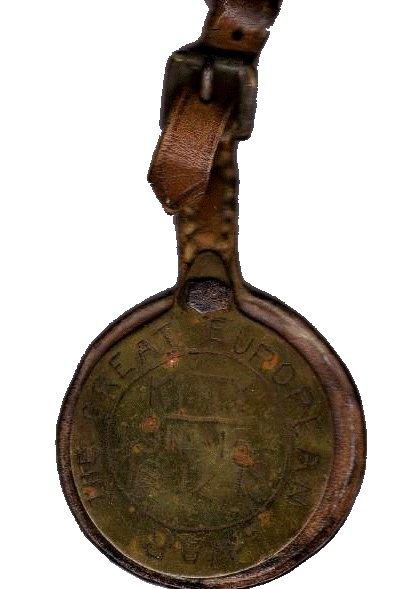 |
Left. This badge was made by Jack for his horse Kitty. It reveals his optimism regarding the duration of the war, as it reads " Kitty. The Great European War. 1914-15 " Then as the war dragged on, each year was added. "-16 ", "-17 ", "-18". |
 Fred Pickett enlisted in the Devonshire Regiment in 1915. The following year he joined the 2/6 Bn. Devonshire Regiment in India, and in 1917 went with the Battalion to Mesopotamia until the end of the war. Fred's war was not one of mud and trenches: for these Devons it was a war of fever, disease and consequent death. Fred Pickett enlisted in the Devonshire Regiment in 1915. The following year he joined the 2/6 Bn. Devonshire Regiment in India, and in 1917 went with the Battalion to Mesopotamia until the end of the war. Fred's war was not one of mud and trenches: for these Devons it was a war of fever, disease and consequent death. |
|
 Jack Heard 1916-1989 |
 Laurie Pitts 1912-1999 |
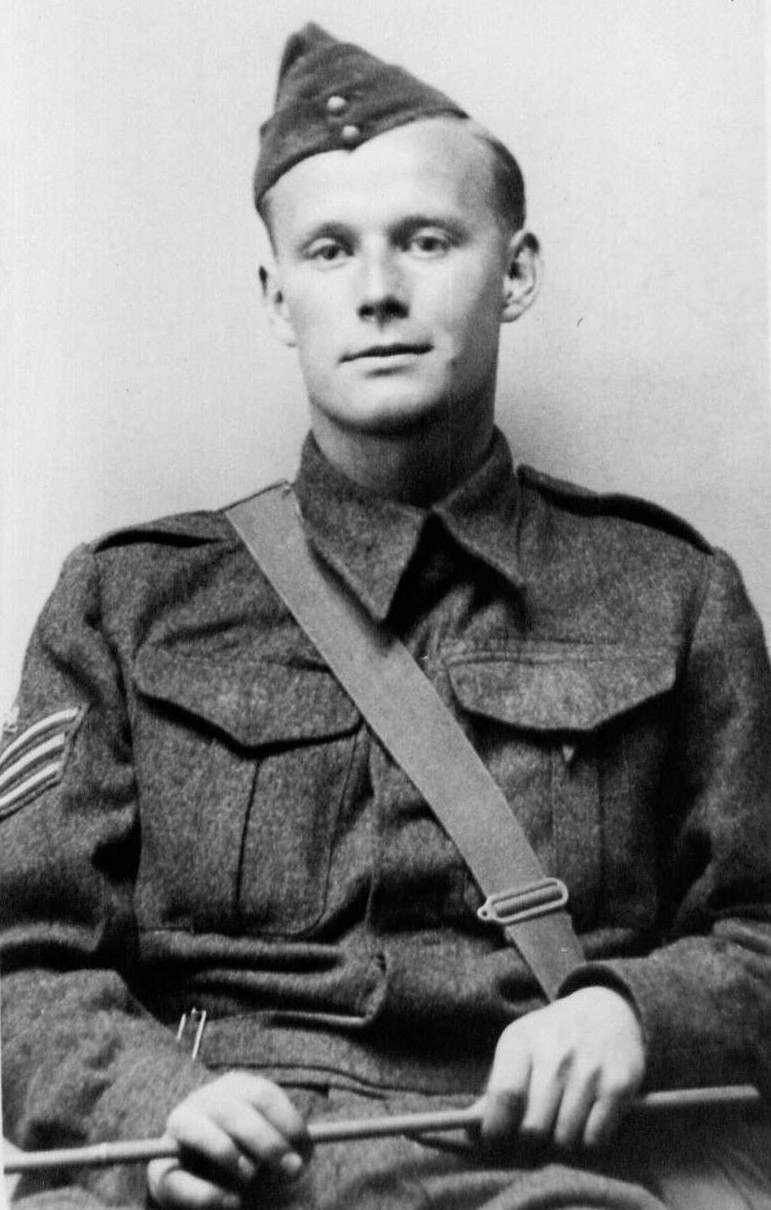 Sgt. Den Heard1918-2001 |
|
 Margaret Pickett 1927-2003 |
 Albert Pickett 1921-1988 |
POW Charles Pickett 1918-1975 in Stalag XXA a prisoner most of the war |
George Blackler 1839--1923 |
 Paul Sirgey 1929-1984 |
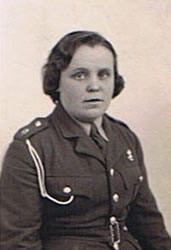 Dorothy Wright 1906-1935 |
 in the Army WW2.jpg) "Jack" Pollard 1916-2000 |
Thomas Comins Pollard 1890-1949 |
|
|
 Alfred Sydney Frayling 1893-1941 |
Donald Fraser 1892-1971 |
 POW Ray Heard 1917-2009 |
|
|
Les Ashplant (1923-2005) had always wanted to be in the RAF, and joined up as soon as he was old enough. Unable to be a pilot, he volunteered for the dangerous role of Air Gunner with Bomber Command. On a mission over Germany to bomb Mannheim in 1943, his plane was shot down, and he earned the distinction of qualifying for the Caterpillar Club, by parachuting from the doomed plane to save his life. Captured by the Germans as he tried to escape to Switzerland, he was eventually taken to Stalag 4b, where he was imprisoned until the arrival of the advancing Russians. He got back to England in 1945. |
Les was photographed by the Germans when he was shot down |
|
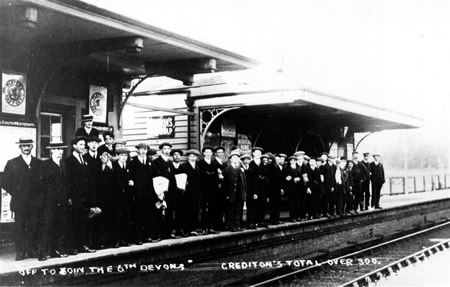 |
Volunteers at Crediton Station, off to join the 6th Bn Devonshire Regiment. Maybe Fred Pickett's departure was like this. Probably taken some time between 1914 and 1916 the postcard proudly proclaims Crediton's total of over 300 volunteers thus far. Over 170 men of Crediton and its surrounding parishes, villages and hamlets did not return. |
 |
|

Medal Display
Top left: Private Fred Ashplant, RAMC. The British War Medal and the World War I Victory Medal.
Top right: Pioneer John Ashplant,
RE. The Mons Star, The British War Medal and the World War I Victory Medal. (Pip, Squeak and Wilfred)
Bottom: Sgt. Albert Hatten, Coldstream Guards. The Mons Star, The British War Medal, the World War I Victory Medal, the 39-45 Defence Medal, and the Special Constable Good Conduct and Long Service Medal.
Pilot Sergeant Kenneth Heard
Sgt Kenneth Heard was posted to 49 Sqdn. in January 1942, based at Scampton in Leicestershire, flying Hampden bombers. He flew as Navigator on Operation Fuller - the Channel Dash - the operation to prevent the breakout of the German warships Scharnhorst, Gneisenau and Prinz Eugen from Brest. His first mission in January was against the ships in Brest. He then attacked the ships in the Channel on 10th February, without success, and on his third mission on 12th February 1942 the aircraft and its crew, Pilot Sgt Phillips, W/OP Sgt Jackson, Sgt Toghill, Air Gunner and Sgt Kenneth Heard failed to return.

Kenneth Heard - back row, 3rd from left, and right
 Bronze memorial in Exeter Cathedral to the officers and men of the Devonshire Regiment who lost their lives in the Great War
Bronze memorial in Exeter Cathedral to the officers and men of the Devonshire Regiment who lost their lives in the Great War

Private Sam Rowe 1902-1943 |
||
 |
Sam Rowe was from at least 6 generations of East
Devonians on his paternal line, and at least 5 generations
from Somerset on his maternal line. But he was brought
up in Mid-Devon, by his uncle and aunt, Walter and Lucy
Thomas, in Shobrooke, where he worked as a mason's labourer on
the estate of the Lord of the Manor, Sir John Shelley. He
played soccer for the Shobrooke team. Sam
married Edith Madge of Crediton, and at the outbreak of the
war he was living there, in Mill Street, with his wife, and
young son and daughter. He would have been fairly old to
have enlisted - in his late thirties at least. 41 was the age
limit for conscription. He joined the Pioneer Corps, which
would have been regarded as perhaps appropriate for a man with
his construction experience. And whilst the average age for
soldiers in World War II was 26, in the Pioneer Corps that
rose to 35. He served as a Private. Sam died during the allied invasion of Italy in September 1943. The main allied landings were at Salerno, beginning on 9th September. During 12th - 14th September, the Germans counterattacked the Allied beachhead at Salerno, hoping to throw them back into the sea. It was during this counterattack that Sam was killed. Then, supported by Airborne reinforcements, and Naval and RAF bombardments, the Allies repulsed the counterattack, and consolidated the beachhead by 16th September. The Allies turned North. Sam is buried at the War Cemetery at Salerno. (Right). |
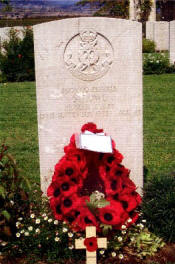 |
 |
Ralston George
Oliver & Joyce Madge
|
||
| Marriage of George Oliver and Joyce Madge, Exeter,19 June 1940 | |||
| The target on that August day was the Nazi
airfield at Aalborg, Denmark. During
the two months of the German campaign in Norway, Aalborg
Airfield had been of immense strategic importance. The airfield would
also prove its usefulness in the coming Battle of Britain. It
had been targeted by the RAF several times. On that day the weather was fairly good, clear, with only a few clouds. The Blenheims approached the target from the South, and immediately German AA guns opened up. The six aircraft from A-flight got through the flak and released their bombs. But they were then attacked by German fighters. As B-flight followed in, about a minute later, the AA gunners had adjusted their aim , and those Blenheims succumbed. George's bomber was the fourth of B-flight to be hit, and it crashed on the airfield, diving almost vertically into the target, killing P/O Hale, Sgt. Boland and George. The Germans recovered what they could of human remains for burial, and quickly filled the smoking crater left by the exploding aircraft, so the airfield could be got into action again. And there R3821 lay undisturbed until in 1995 when after its discovery, it was excavated and removed . On 13th August, all of B-flight were brought down. A-flight were almost all destroyed on the return from Aalborg, only one aircraft surviving. George and his comrades who did not manage to survive were buried in Vadum Churchyard, Aalborg. He was killed less than 8 weeks after his wedding to Joyce. On a raid against German armour in May 1940, eleven of twelve aircraft had failed to return. And this had happened again just 3 months later. 82 squadron became known as "The Squadron That Died Twice." |
|||
Lance Serjeant Alexander Warder and the Lisbon Maru
|
||||
| Alexander Charles Warder was a Fey cousin, born in Portsmouth 0n 6 April 1911. When war broke out he joined the Royal Artillery. He was posted to the 12th Coast Regiment, which was stationed in Hong Kong. The regiment was captured by the Japanese at the fall of Hong King in December 1941. Alexander was captured on 16 December. He was imprisoned in Shamshuipo Pow camp, Hong Kong. On 27 September, 1942, the Japanese ship Lisbon Maru to Japan transported 778 Japanese army personnel going home, 25 men guarding the prisoners, and 1,816 British POWs captured after the fall of Hong Kong, including Alexander Warder. They were being transferred to POW camps in Japan. Prisoners were detained in 3 holds in shocking conditions, without latrines, fresh water or air, with men suffering from dystentry, diorrhoea and vomiting. At about 7.00am on 1 October 1942 the Lisbon Maru was torpedoed by the US submarine Grouper about six miles off Tung Tusham Island on the Chinese coast, near Shanghai. |
 The
sinking of the Lisbon Maru carrying POWs The
sinking of the Lisbon Maru carrying POWs |
|||
| There was no sign that there were POWS on the Japanese vessel. Although most of the torpedoes missed, the stern of the ship suffered a hit.With many Japanese trops on board and with the ship armed, there had been no reason for the US submarine crew to suspect she was anything but a legitimate target. With the ship taking on water, most of the Japanese troops were evacuated, leaving the crew and a skeleton guard. The hatches were battened down over the holds, and prisoners began to die there. Those prisoners who were able, battled to break through the battened hatches. Some were shot by the remaining guards but a number escaped into the sea. By 10.45 pm on 2 October the Lisbon Maru finally sank. Some of the escaped prisoners were shot by Japanese sailors on the vessells that had arrived. Some were rescued. Chinese fisherman also tried to rescue the prisoners, and hide them on the islands. All but three were recaptured. Of the 1816 POWs who had left Hong Kong only 973 survived, leaving 843, including Lance Serjeant Alexander Warder, who were assumed to have been killed by the Japanese firing on them or drowned – many of the latter being non-swimmers, without life-jackets or other means of support, and some, it was reported, as the result of shark attack. | ||||
The Devonshire Cemetery
The first day of the Battle of the Somme, 1st July 1916, saw the 9th Bn. Devonshire Regiment holding trenches at Mansell Copse, near the village of Mametz. They were to attack towards the nearby village of Fricourt. Lt. Duncan Martin of A Coy. had identified the threat from German machine gunners in what had become known as Shrine Alley - the field of fire from machine guns established in a shrine in the village cemetery. As the 9th Bn. emerged from their trenches they were cut down by machine guns as predicted. The 9th continued to advance, along with the 2nd Gordons, and supported by the 8th Bn. Devonshire Regiment.
By 6.00pm the Division had achieved its objective and was being consolidated. But at a heavy price. The 8th had lost 3 officers killed, 47 men killed or missing and 7 officers and 151 men wounded. The 9th had lost 8 officers (including Lt. Martin) and 196 men killed or missing, 9 officers and 267 men wounded - 463 casualties of the 775 in action. Rather unusually the dead were buried in the trench they had left, by a working party led by the padre. Comrades erected a wooden plaque to mark the burial. Its legend read:
Mametz. They were to attack towards the nearby village of Fricourt. Lt. Duncan Martin of A Coy. had identified the threat from German machine gunners in what had become known as Shrine Alley - the field of fire from machine guns established in a shrine in the village cemetery. As the 9th Bn. emerged from their trenches they were cut down by machine guns as predicted. The 9th continued to advance, along with the 2nd Gordons, and supported by the 8th Bn. Devonshire Regiment.
By 6.00pm the Division had achieved its objective and was being consolidated. But at a heavy price. The 8th had lost 3 officers killed, 47 men killed or missing and 7 officers and 151 men wounded. The 9th had lost 8 officers (including Lt. Martin) and 196 men killed or missing, 9 officers and 267 men wounded - 463 casualties of the 775 in action. Rather unusually the dead were buried in the trench they had left, by a working party led by the padre. Comrades erected a wooden plaque to mark the burial. Its legend read:
"The Devonshires held this trench.
The Devonshires hold it still."
Fallen in World War II
Reginald Adkins, Fusilier, 1st Bn Royal Inniskilling Fusiliers. Died 19 Jan 1945 in a Japanese POW Camp, age 32.
Commemorated in Rangoon War Cemetery.
Geoffrey Adams, Captain, Royal Engineers,
attached 6 Bombay Pioneers, Indian Pioneer Corps. Died 17 Feb
1942, age 26. Remembered on Rangoon Memorial.
Basil Bray, Surgeon Lt. RNVR, HMS Greyhound. Died 22 May 1941 age 27. Remembered on the Portsmouth Naval Memorial.
Leslie Stewart Norrish Conbeer,
Gunner, Royal Artillery,195 Bty., 61 (11th Bn. The London Regt.) H.A.A. Regt.
Died 30 November 1943, age 22
Buried in Catania War Cemetery, Sicily, Italy.
Albert George Greenslade, Marine, Royal
Marines, HMS President III - S.S. Empire Eland.
Died 15 Sep 1941, age 44. Remembered on the Plymouth Naval
Memorial.
William Hansen, Lieutenant (Junior Grade), US Naval
Reserve, USS Helena. Died 6 July 1943, age 22. Remembered in the Manila
American Cemetery.
Donald James Harvey, Sergeant, RAFVR, 422
Squadron. Died 24 May 1944, age 21. Commemorated at the RAF
Memorial, Runnymede.
Kenneth Heard, Sergeant, RAFVR, 49 Squadron. Died 12 February 1942, age 20. Commemorated at the RAF Memorial, Runnymede.
William Henry Jackman, Private, 5th Bn Dorsetshire Regt.
Died 11 July 1944, age 28. Buried in Secqueville-en-Bessin War Cemetery,
France.
Ernest John Madge, Able Seaman, RN, HMS Matabele.
Died 17 January 1942, age 27. Remembered on the Plymouth Naval
Memorial.
Ronald Mallett, Corporal, Royal Corps of Signals, 201st Bde.Sig.Sec. Died 2 April 1943, age 24. Buried in Taukkyan Cemetery, Burma.
Ralston George Oliver, Sergeant, Royal Air Force,
82 Squadron. Died 13 August 1940, age 23. Buried at Vadum
Cemetery, Aalborg, Denmark.
Harold Parker, Leading Signalman, RN ,
HMS Harvester. Died 11 March 1943. Remembered on the Chatham Naval Memorial.
Arthur Pickett, Sick Berth Attendant, RN,
HMS Shrapnel. Died 21 July 1942, age 31. Remembered at the Wandsworth Crematorium.
Clifford Pickett, Major, the Kings Regt. , attd 2nd Bn Worcestershire Regt. Died 9 April 1945, age 33. Buried in Taukkyan Cemetery.
Samuel Rowe, Private ,242 Coy., Pioneer Corps. Died 13 September 1943, age 41. Buried in Salerno War Cemetery.
Arthur Salter, Guardsman, 3rd Bn. Coldstream
Guards. Died 9 September 1943, age 34. Buried in Salerno War
Cemetery.
Joseph Cecil Wentworth Smith, Able Seaman,
RN, HMY Sappho. Lost at sea 30 September 1940, age 36. Remembered on the Plymouth Naval Memorial.
Alexander Charles Warder, Lance Serjeant
Artificer, 12 Coast Regt, Royal Artillery. POW. Lost with the
sinking of the Lisbon Maru, 2 Oct 1942,
age 31. Remembered on Sai Wan Memorial, Hong Kong.
Henry "Joe" Whidden , Private, 2nd Bn The Welch Regiment. Died 28 July 1945, age 21. Buried in Rangoon War Cemetery.
Maurice Willing, Flt Lt, Royal Australian Air Force. Missing 19 Jan 1942, age 23. Remembered at Ambon Memorial .
Olivia Willing, Student Nurse, City Hospital, Plymouth. Died 20 March 1941, age 19. Buried at Efford Cemetery, Plymouth.
